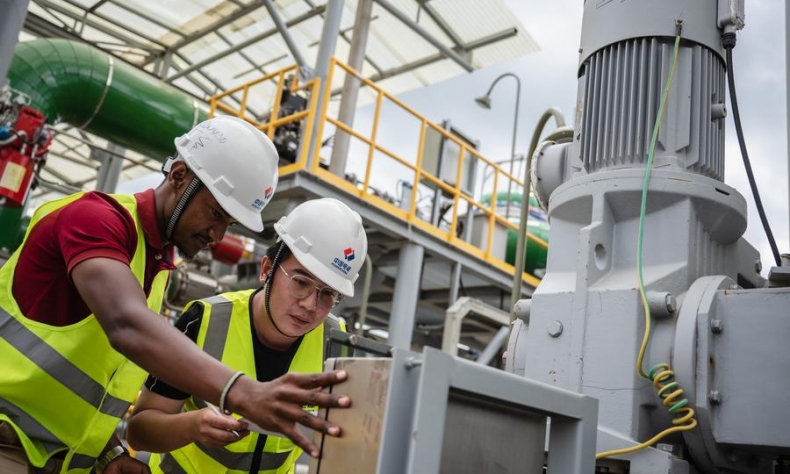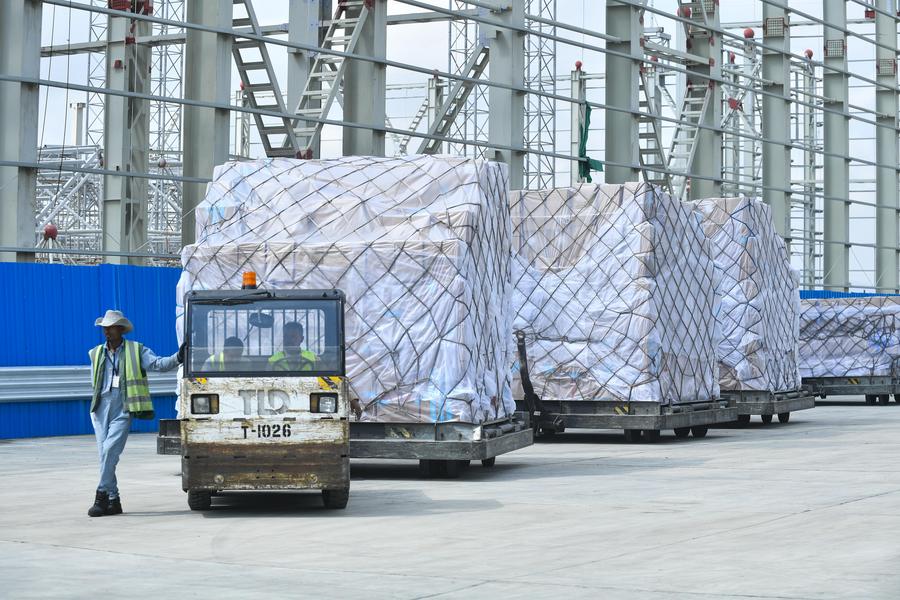Deepening Collaboration

China and Africa need to further align development strategies to realise the immense potential of economic cooperation.
Humming factories, bustling ports, and shuttling merchants highlight the vibrancy of China-Africa economic and trade cooperation. Over the years, this partnership has grown significantly, optimising trade structures and fostering mutual development. This deepening collaboration is evident in China’s role as Africa’s largest bilateral trading partner for 15 consecutive years.
During the first seven months of 2024, trade between China and African countries reached $167 billion, reflecting a 5.5-percent increase compared to the same period in 2023. According to the International Monetary Fund, approximately 20 percent of Africa’s exports now go to China, while 16 percent of its imports originate there. Metals, mineral products, and fuel account for around three-fifths of Africa’s exports to China, while manufactured goods, electronics, and machinery dominate its imports from China. Furthermore, China’s direct investment stock in Africa has surpassed $40 billion, making it one of the continent’s largest sources of foreign investment.
Beyond the trade volume, there has been a notable improvement in the trade structure. China’s imports of African agricultural products like nuts, fruits, vegetables, and flowers have increased substantially, with growth rates of 130 percent, 32 percent, 14 percent, and 7 percent, respectively, from 2022 to 2023. Initiatives like the “green channel,” announced at the eighth Ministerial Conference of the Forum on China-Africa Cooperation (FOCAC) in November 2021, have facilitated this growth. This channel streamlines inspection, quarantine processes, and customs duty exemptions, boosting African agricultural exports such as pineapples, avocados, and citrus fruits.
African products, from Madagascar’s essential oils to South Africa’s wine and Senegal’s cosmetics, are increasingly popular among Chinese consumers. Simultaneously, China’s exports to Africa, including technology-intensive green products like new energy vehicles, lithium-ion batteries, and photovoltaics, are advancing Africa’s green energy transition.

Extensive collaboration
The digital economy has emerged as a new frontier in China-Africa cooperation. Chinese firms have been instrumental in narrowing the digital divide by building infrastructure and facilitating Africa’s digital transformation. Activities such as the African Goods Online Shopping Festival show the growing linkages, where African and Chinese livestreamers promote African products to Chinese buyers. Cross-border e-commerce platforms under the Silk Road e-commerce collaboration enhance trade facilitation and inject momentum into economic ties.
The high growth of China-Africa economic collaboration stems from the complementary nature of their economies. China offers advanced technologies, equipment, and capital, while African countries possess abundant natural resources and a growing labour force. This complementarity forms a strong foundation for cooperation in fields such as agriculture, infrastructure, manufacturing, and services. Strengthening trade ties between the two regions helps to leverage their respective advantages and vast markets, achieving mutual gains and fostering a win-win partnership. By synergising development strategies, China and Africa are unlocking their development potential. African exports of high-quality agricultural products and minerals are matched by the introduction of new technologies and business models from China in areas such as the digital economy, clean energy, trade logistics, and finance.
Infrastructure is a key element of Africa-China cooperation. Enhancing connectivity across Africa is central to boosting trade and economic integration. Chinese firms have built or upgraded over 10,000 km of railways, around 100,000 km of highways, nearly 1,000 bridges, and around 100 ports in Africa over the past decade. They have also constructed numerous hospitals and schools.
The Belt and Road Initiative (BRI) and FOCAC are key platforms strengthening China-Africa economic ties. BRI, a global development programme focusing on infrastructure, aligns with Africa’s Agenda 2063, a strategic framework for the continent’s socio-economic transformation over the next 50 years. However, as economic growth slows, both sides must adopt a prudent approach to sustain their trade and investment relationships.
Looking ahead
In the coming years, China’s private sector will likely play a bigger role in trade and investment in Africa compared to state-owned enterprises. In fact, more than 70 percent of the 3,000 Chinese enterprises that have shown interest in Africa are private sector companies. It is likely that the African Continental Free Trade Area (AfCFTA) will accelerate this trend by promoting the growth of regional value chains and creating a more unified African market, making it more attractive for Chinese businesses.

Officially launched in 2021, the AfCFTA creates a single market projected to grow to 1.7 billion people and $6.7 trillion in consumer and business spending by 2030. As a result of the preferential trade agreement, international exports as well as intra-African trade will grow, particularly in agriculture and green technology minerals. It is hoped that this will open up new business opportunities for both local and global businesses across the continent, enabling them to enter and expand into new markets. The first private sector action plan for the AfCFTA was introduced during the annual meeting of the World Economic Forum in January 2024.
To fully realise the immense cooperation potential, both sides need to work on aligning the AfCFTA, FOCAC, and the BRI strategies. Investments should be targeted at catalysing the industrialisation and manufacturing plans of the region, as well as enhancing trade connectivity. Understanding the mutual benefits of enhancing coordination and synergy, the Chinese government, at the third Belt and Road Forum for International Cooperation in October 2023, announced that the next phase of BRI would shift to “small yet smart” projects, with a focus on green development and the digital economy.
The 10 partnership actions announced at the FOCAC Beijing Summit held in 2024 cover areas of mutual learning among civilisations, trade prosperity, industrial chain cooperation, connectivity, development cooperation, health, agriculture and livelihoods, people-to-people and cultural exchanges, green development, and common security. These actions will help African countries to expand their supply chains, feed their factories, and enhance their industrial development.
In the future, many of these factories will feature collaborations between Chinese and African entrepreneurs, as well as government agencies, producing consumer goods for the up-and-coming middle class in Africa. Due to the fact that China’s industrial and supply chains complement each other strongly, offering a wide range of opportunities for cooperation between China and Africa, this is an important development. As a matter of fact, Africa needs China, and China needs Africa as well. There is no doubt that China’s investments, trade, as well as its foreign aid, loans, and grants, play a major role in promoting Africa-China economic cooperation and enhancing the development of Africa, especially its infrastructure. However, it is worth noting that, in the long term, Africa must engage with China in a more integrated manner, pushing for more balanced trade with greater local value addition.
The author is Executive Director of Centre for Nigerian Studies, Institute of African Studies, Zhejiang Normal University.
 Facebook
Facebook
 Twitter
Twitter
 Linkedin
Linkedin
 Google +
Google +










